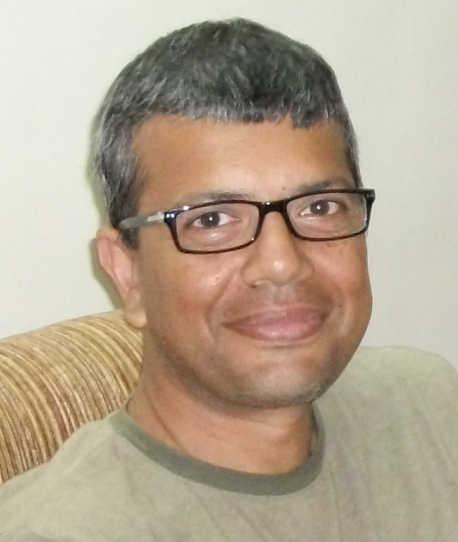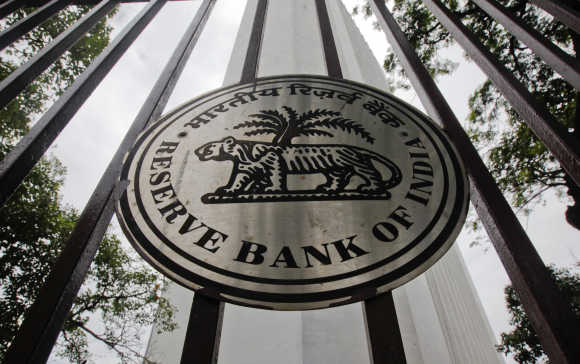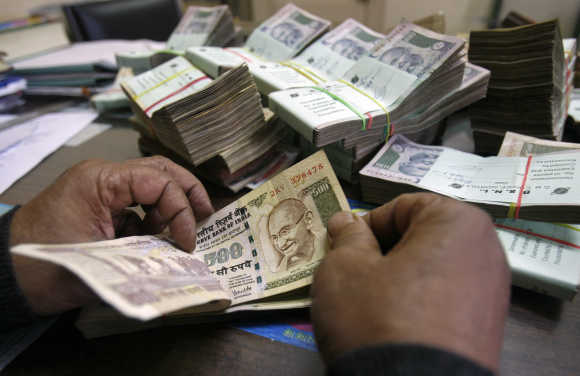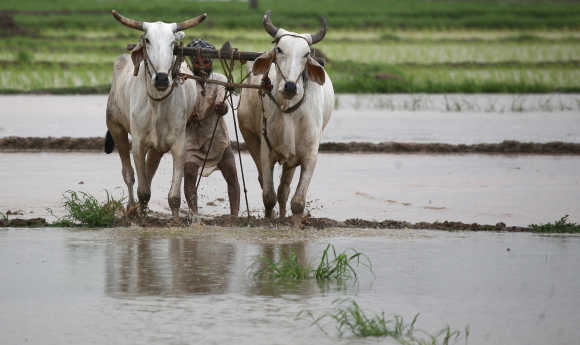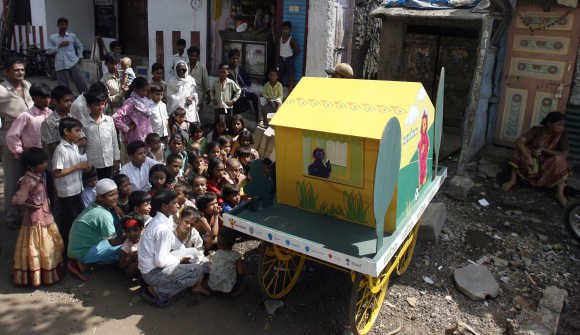 | « Back to article | Print this article |
'Govt is running from one crisis to another'
India may need to take a fresh look at its monetary policy, says Amartya Lahiri, professor of Economics at the University of British Columbia.
Lahiri, who has written several papers, including Breaking the Caste Barrier: Intergenerational Mobility in India, with Viktoria Hnatkovska and Sourabh B Paul, says the image that the government is projecting is of one that is running from one crisis to another.
Reforms, growth and rise in service sector have helped SC/ST climb the social and economic ladder, says Lahiri in an email interview to Faisal Kidwai
Here are the excerpts:
You have said that when it comes to monetary policy, India follows practices of the developed world even though this approach is not appropriate for the country. Why is the current monetary policy not appropriate for India?
What I have said is that the current policy being pursued may not be appropriate. The RBI's monetary policy appears to follow developed country practices which are based on the idea that prices adjust very slowly. The slow response of prices implies that if the central bank eases monetary policy during a downturn, then the extra liquidity in the hands of people does not immediately lead to higher prices.
The resultant increase in purchasing power of consumers induces higher demand for goods which, in turn, leads firms to expand production to meet this demand. This is the standard thinking. The effectiveness of this kind of monetary policy intervention is the subject of a lot of debate in developed countries, with opinions quite divided.
There have, in fact, been a number of studies in which researchers have examined the actual degree of price variability in the publicly available data in these countries. The takeaway number from these studies is that the typical price of goods remains set for around four months at a time. With this level of price rigidity, researchers often argue that monetary policy cannot be too effective in stimulating output in developed countries.
The problem with applying these principles to India directly is that there is virtually no study that I know of that has tried to examine the speed with which prices of goods and services change in India. Given the higher structural inflation rate in India (relative to developed countries) the speed of price adjustment is likely to be even faster in India.
Click NEXT to read more...
'Govt is running from one crisis to another'
If the RBI does have data on this then they should make it publicly available, as is done in developed countries, to enable researchers to examine the evidence independently. Short of this, pursuing activist monetary policy based on the idea of inflexible prices is akin to flying a plane on auto-pilot without knowing whether the auto-pilot is responding to the right data or not.
Reserve Bank of India usually reduces interest rates when there is an economic downturn, but you say this needs to change. Why do you think this practice needs to change and what's the alternative approach you propose?
This practice is known as counter-cyclical monetary policy. As I said above, it is based on the idea that prices adjust very slowly over time, the evidence for which is simply not known in India. There is another very direct way in which monetary policy affects the daily lives of people. It redistributes purchasing power from one group to another, in particular between people who have access to banks (or financial intermediaries) and those that don't.
When the RBI changes the repo or the reverse repo rate, it alters the rate at which banks get access to funds which, in turn changes the rates at which banks borrow or lend to its customers. Whether it affects you or me directly depends on whether we transact with banks.
As is well known, less than half of all Indians have access to formal financial networks. About 145 million households (out of the about 210 million households in India) are completely excluded from banking services with less than one in twelve villages being actually covered by any formal financial service.
So when the RBI changes monetary policy for the country it actually changes economic conditions directly for only a small minority of the population. When liquidity is injected in the economy, it goes disproportionately to those people who have access to banks thereby redistributing resources in their favour.
Click NEXT to read more...
'Govt is running from one crisis to another'
When it withdraws liquidity from the system it is the opposite: resources get withdrawn disproportionately from those that have access to banks, thereby redistributing in favour of those that do not.
With this in mind, now imagine the man selling bananas in a rural village. His typical method of saving is holding liquid cash. While people with access to banks and credit cards can tide over temporary ups and downs in income by borrowing from these resources, this banana seller only has his cash holdings to buffer against periods when his income falls, say during a recession.
He would benefit if the purchasing power of his liquid cash increased during these periods. This would happen if there was a fall in the prices of goods and services that the banana seller generally consumes. If monetary policy were targeted at the banana seller then it would require the RBI to induce a disinflation in the economy during economic downturns.
This would entail tightening monetary policy, i.e., raising interest rates, not reducing them. This pro-cyclical policy is clearly not costless. It will negatively affect businesses and consumers who have access to banks by raising the cost of credit for them, precisely when they need more credit. However, their interests would have to be weighed against the interests of the vast multitudes that have no access to banks whatsoever.
What I have suggested is that this redistributive aspect of monetary policy should be explicitly incorporated into the RBI's decision making process instead of just basing policy on developed country practices whose applicability to India remains relatively unknown.
There is a third option too for the RBI. It can become an explicit inflation-targeter. A number of smaller countries like Australia, New Zealand, Chile, Mexico, South Africa, etc., have switched to this policy.
Click NEXT to read more...
'Govt is running from one crisis to another'
It would involve the RBI getting out of the "growth" business completely and stating openly an inflation target that it wants to attain. It would then have to adjust monetary policy to attain its inflation target. If the RBI openly announces this policy and sticks to it for a while, it would build its credibility as an inflation fighter.
This would take away the guess work of the private sector regarding what the RBI might do, thereby shielding the process from speculative and self-fulfilling behaviour.
Let's talk about the slowdown in Indian economy. What should the government do to bring down inflation and boost growth?
Interest rates are ridiculously low; in fact real rates are negative right now. So, it is not an issue of monetary policy being too tight to accommodate an increase in investment. The problem in India right now is one of policy paralysis. The government needs to get going on the reform agenda and build optimism among investors regarding where the country is headed. Investment has become tepid due to investor uncertainty. Hence, the solution is getting the reform-process moving again.
At the moment, the image that the government is projecting is of one that is running from one crisis to another within a coalition that is pulling in different directions. Whether it is corruption, divestment, allowing foreign investment in designated sectors, fuel subsidies, natural resource auctions, etc., there is no clarity or united policy vision at all that the government is projecting. Investors and businesses need stability, clarity and openness of the policy framework. The government is currently misfiring on all these dimensions.
Click NEXT to read more...
'Govt is running from one crisis to another'
You have extensively studied the rural-urban divide in India. Could you tell us some of the major points that stood out in your research?
In joint research with Professor Viktoria Hnatkovska, I examined the evolution of the rural-urban divide in education attainment, occupation choices and wages between 1983 and 2009-10 using data from the National Sample Survey.
We have found that the gap between rural and urban areas in India has declined strikingly during this period with the sharpest narrowing being in education and wage gaps. The number of years of education of the typical rural worker more than doubled from two years in 1983 to five years in 2009-10. During the same period, the typical urban worker increased his education level from around six years to eight years.
As a result, the education gap between the two declined. Also, the median wage premium of urban workers relative to rural workers fell from 101 per cent in 1983 to just 11 per cent in 2009-10. These results for India stand in sharp relief to the experience of China where recent research suggests that rural-urban income gaps actually widened between 1988 and 2002.
These are all welcome signs.
We believe this is a very important finding since India has been undergoing a massive economic transformation over this period with agriculture gradually losing ground both in terms of employment as well as the share of GDP. Economies undergoing such structural transformations can face social disruptions if they are unable to smoothly reallocate people from agriculture to alternative occupations.
Our results suggest that the reform process and the aggregate growth pick-up in India has been able to accomplish this task quite well so far. What we found even more interesting is that most of this reallocation of occupation and jobs was not accompanied by a massive rural to urban migration.
Click NEXT to read more...
'Govt is running from one crisis to another'
Instead, we found that an expansion of blue collar jobs within rural areas (as well as some expansion of white collar jobs) accomplished most of the workforce reallocation. This, I believe, is a testament to the equity of the reforms and growth process in India. They appear to have created new opportunities across the rural-urban spectrum.
The other interesting result we found was that the rural poor are better off than the urban poor. Specifically, after adjusting for differences in cost of living between rural and urban areas, the bottom 20 per cent of the rural population earn higher wages and have greater mean per capita consumption levels than the bottom 20 per cent of the urban workforce.
This, importantly, is a post-reform phenomenon. In fact, the urban poor were better-off relative to the rural poor till 1993-94. However, the urban poor is a demographic that is not focused on too much in policy debates. Most of the pro-poor or poverty relief programmes such as NREGA appear to be geared towards the rural poor.
Part of the problem here is that the manufacturing sector has exhibited very tepid growth during this post-reform phase. Until industrial growth becomes robust, it will be hard to incorporate the urban poor fully into the growth process. This is where the next round of reforms needs to focus, whether it be labor policy or industrial policy.
Another area that you have studied is caste mobility. You found that the probability of an SC/ST child changing his level of education attainment relative to the parent was just 42 per cent in 1983 but rose sharply to 67 per cent by 2004-05.You also discovered that the elasticity of wages of children with respect to the wages of their parent has declined from 0.90 to 0.55 per cent for SC/ST households and from 0.73 to 0.61 per cent for non-SC/ST households. What do you think are the causes for this sharp improvement in SC/ST figures?
I believe that a few factors have been important in inducing these improvements in the fortunes of SC/STs.
Click NEXT to read more...
'Govt is running from one crisis to another'
The first is the role of aspirations. The reforms and the aggregate growth pick-up have been accompanied by a sharp increase in service sector jobs (both blue and white collar). These jobs pay more than agricultural wages but require some education and often some working knowledge of English. People across the board have come to understand that.
Hence, the tremendous focus of parents across the socio-economic spectrum on education for their children.
Since the SC/STs were further behind to start with, they have shown the fastest growth. Second, from the perspective of prospective employers, in the post-reform phase, competition between businesses has increased a lot. In this environment, it is difficult to continue practicing discriminatory (caste-based) hiring and wage practices and still survive as a viable commercial entity.
I also believe that role models are important. Seeing people from your own background succeeding raises the self-belief of others in the same community. As more and more SC/STs have used the expanding opportunities to climb the socio-economic ladder, others from their communities (parents and children alike) have become more alive to these newer possibilities.
Reservations may also have contributed to the catch-up through this route. Lastly, the fact that most of the newer opportunities in India have opened up in the service sector has probably helped. Services are mostly unorganised and do not have organised labour unions. This has allowed relatively unfettered access for SC/STs to the newly created jobs. The industrial sector, on the other hand, is more organised and has a stronger presence of unionised labour.
This makes accessing jobs in the industrial sector often more difficult than in the service sector for someone from an agrarian background without family or community connections to that industry.
